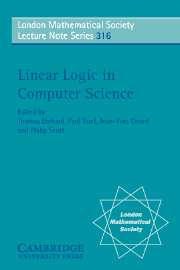Book contents
- Frontmatter
- Contents
- Preface
- List of contributors
- Part one Tutorials
- Part two Refereed Articles
- 5 An Axiomatic Approach to Structural Rules for Locative Linear Logic
- 6 An Introduction to Uniformity in Ludics
- 7 Slicing Polarized Additive Normalization
- 8 A Topological Correctness Criterion for Multiplicative Non-Commutative Logic
- Part three Invited Articles
7 - Slicing Polarized Additive Normalization
Published online by Cambridge University Press: 17 May 2010
- Frontmatter
- Contents
- Preface
- List of contributors
- Part one Tutorials
- Part two Refereed Articles
- 5 An Axiomatic Approach to Structural Rules for Locative Linear Logic
- 6 An Introduction to Uniformity in Ludics
- 7 Slicing Polarized Additive Normalization
- 8 A Topological Correctness Criterion for Multiplicative Non-Commutative Logic
- Part three Invited Articles
Summary
Abstract
To attack the problem of “computing with the additives”, we introduce a notion of sliced proof-net for the polarized fragment of linear logic. We prove that this notion yields computational objects, sequentializable in the absence of cuts. We then show how the injectivity property of denotational semantics guarantees the “canonicity” of sliced proof-nets, and prove injectivity for the fragment of polarized linear logic corresponding to the simply typed λ-calculus with pairing.
Introduction
The question of equality of proofs is an important one in the “proofsas-programs” paradigm. Traditional syntaxes (sequent calculus, natural deduction, …) distinguish proofs which are clearly the same as computational processes. On the other hand, denotational semantics identifies “too many” proofs (two different stages of the same computation are always identified). The seek of an object sticking as much as possible to the computational nature of proofs led to the introduction of a new syntax for logic: proof-nets, a graph-theoretic presentation which gives a more geometric account of proofs (see). This discovery was achieved by a sharp (syntactical and semantical) analysis of the cut-elimination procedure.
Any person with a little knowledge of the multiplicative framework of linear logic (LL), has no doubt that proof-nets are the canonical representation of proofs. But as soon as one moves from such a fragment, the notion of proof-net appears “less pure”. A reasonable solution for the multiplicative and exponential fragment of LL (with quantifiers) does exist (combining and, like in).
- Type
- Chapter
- Information
- Linear Logic in Computer Science , pp. 247 - 282Publisher: Cambridge University PressPrint publication year: 2004
- 5
- Cited by



